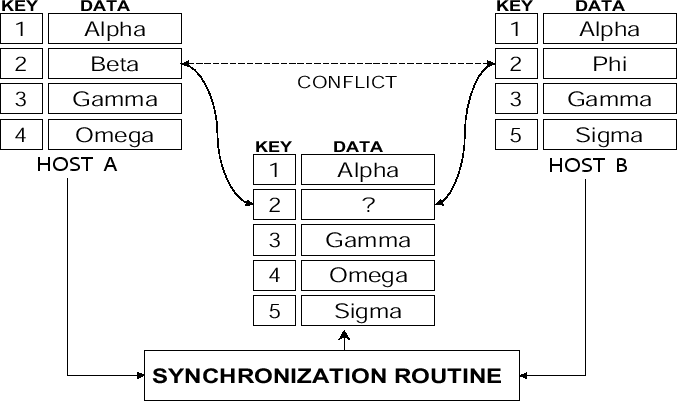



Next: Scalability in Mobile Device
Up: Contemporary Synchronization Technologies
Previous: Contemporary Synchronization Technologies
Contents
Conflicts
Inherent to any data synchronization routine
is the possibility of a conflict. Conflicts arise when the
same record (a record identified by the same key) is modified
locally on different hosts. In such cases the synchronization
routine has to make a decision about which data to pass into the
new synchronized database and which data to ignore. Often,
decisions are made on criteria like keeping the more current data
(using time stamps) or by a user specified preference. For
example, a particular user who makes changes to his appointment
schedule on his PDA while his secretary makes changes to his
appointment schedule on an office PC might want that the PDA data
(updated by him) always overrides the PC data (updated by his
secretary) in case there is a conflict.
Figure 2.1:
Synchronization and
Conflicts
 |
An instance of conflict is shown in Figure 2.1.
The record with key value  in the database held by Host
in the database held by Host  and
Host
and
Host  has different data. It is up to the synchronization
routine to decide what value the data field pointed by the key
has different data. It is up to the synchronization
routine to decide what value the data field pointed by the key  should be written to synchronized database, as shown in the
figure. These decisions are resolved manually in case there is no
rule set by the user about which data should be overwritten.
We will not address conflict resolution issues here, a good
discussion of which can be found in [16].
should be written to synchronized database, as shown in the
figure. These decisions are resolved manually in case there is no
rule set by the user about which data should be overwritten.
We will not address conflict resolution issues here, a good
discussion of which can be found in [16].




Next: Scalability in Mobile Device
Up: Contemporary Synchronization Technologies
Previous: Contemporary Synchronization Technologies
Contents
Sachin Kumar Agarwal
2002-07-12
